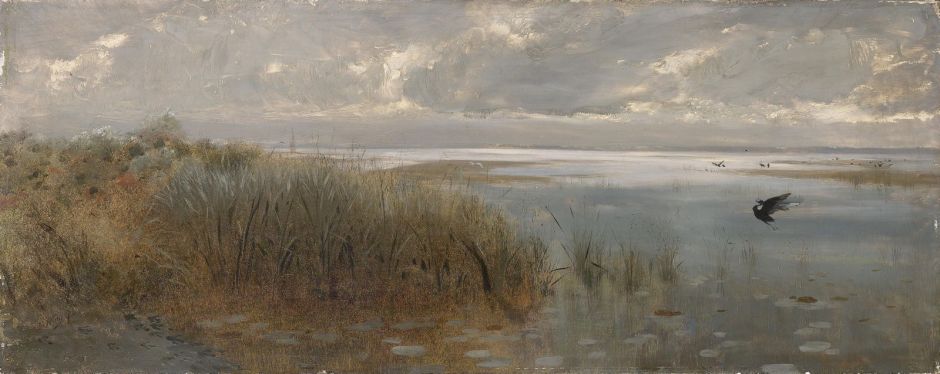In case yesterday’s introduction to a new series on paintings of mountains has left you feeling giddy, this weekend I come down towards sea level with two articles looking at paintings of wetlands. These are seemingly endless plains of wasteland where water and land are intermingled. Sadly, they aren’t endless, as during the last couple of centuries large areas have been drained and lost to nature. And over the last few summers, remaining wetlands have been drying out at an alarming rate. Soon these paintings may be our only reminders of these lands of geese, waders, reeds and wilderness.

Caspar David Friedrich’s Large Enclosure from about 1832 looks towards the setting sun as it’s hidden behind a band of cloud just above the horizon. A plain near Dresden, Germany, is dissected by shallow pools of water, with a river (presumably the Elbe or a tributary) behind. On the river is a single boat, a simple sail lightly inflated by a gentle breeze from the right. Two figures are visible on the boat. Behind that, rows of trees with dense foliage are silhouetted against the receding plain and sky.

Friedrich’s successor Carl Friedrich Lessing painted this Silesian Landscape in 1841, showing the great floodplain near where he was born. In all that great expanse of countryside there is but a single figure, who is walking along the rough track into its dusk light. Silesia consists largely of the basin of the upper and middle Oder River.

Ford Madox Brown painted his famous view of Walton-on-the-Naze in 1860. He’s believed to have started this when he visited the coastal village in north-east Essex in late August 1859, but cannot have worked long at it en plein air before returning home. In addition to fine detail, it incorporates two unusual features: ephemeral lighting effects by way of its rainbow, rising full moon, and setting sun, and inclusion of the artist and his family as its main figures. This expanse of salt-marsh is known as the Backwaters, and much of it remains undeveloped today.

The Italian Impressionist Giuseppe De Nittis painted this Seascape near Naples in 1873, early in his career.

The American artist Martin Johnson Heade was a latecomer to landscape painting, but made a speciality of painting coastal salt marshes in New England, before he moved to Florida in 1883. In 1877, he seems to have made his way to the southern edge of Maine, to paint a stretch of marsh near the new tourist resort of York Harbor, Coast of Maine. This is a remarkable contrast from Maine’s rough and rocky coast further north and east.

Volodymyr Orlovsky’s Harvesters from about 1878 shows labourers cutting a crop with scythes, on the elevated bank beside one of the major rivers in the Pontic Steppe of Ukraine or south-western Russia. In the right half of the painting, seemingly endless wetland stretches to the horizon. The river might be the Dnipro or the Don.

Although better known for wild geese, those who live in wetlands have commonly kept domestic varieties. In this loose painting by Teodor Axentowicz from 1883, his Goose Girl walks with a large flock of geese on flat and marshy land beside a river.

Adrian Stokes was one of many painters who visited the artists’ colony at the northern tip of Jylland (Jutland), Denmark. When he was there in the summer of 1886, he painted Hunters on the Moor, North of Skagen, showing a pair of hunters in the flat wetlands to the north of the village of Skagen.

Finally for today, Évariste Carpentier painted De Kempen in August in a heathland and wetland area on the border between the Netherlands and Belgium. It’s known as Campine in French, or De Kempen in Dutch, and lies to the east of Antwerp. Among the cattle and people is a woman artist, who has set up her easel to paint under a small white parasol.

